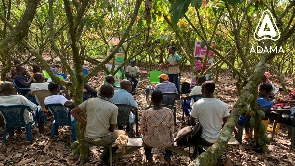Opinions of Wednesday, 10 January 2024
Columnist: Joshua Banana Awutey
The battle for the golden bean: A deep dive into cocoa insecticides for West African farmers
West Africa, the heartland of cocoa production, pulsates with the promise of rich, dark chocolate. But beneath the lush canopy, a silent war rages against tiny invaders - insects that threaten the very lifeblood of communities and national economies. Equally, diseases could wipe out an entire farm with zero revenue at the end of a cocoa season and could also cost governments millions of dollars to rehabilitate such farms.
To understand this battle and equip farmers with the tools to win, we must delve deeper into the world of Cocoa insecticides.
The enemies at the gates:
Mirids: The cocoa mirid is a major insect pest of cocoa and it attacks almost every part of the cocoa tree from the pods, leaves, shoots, branches, and stems through its piercing mechanism. Its destructive impact is so devastating that, if not checked and controlled, yield losses are estimated to reach over 70%.
Cocoa pod borer: This is another insect pest of cocoa that should be of major concern to farmers and other key stakeholders in the cocoa sub-sector. The borers target both premature and matured pods. Their activities caused the pods to ripen prematurely and abort as they were causing serious yield drops or losses. The larvae of some other borers tunnel into pods, devouring beans and rendering them unmarketable. Their hidden damage can go unnoticed until it's too late, leaving farmers counting their losses.
Cocoa Mealy bugs: These “silent killers”; sap-sucking villains drain the life from leaves and pods, causing stunted growth and yield losses. They tend to live a symbiotic life with black ants as the ants feed on their sugary honeydew secretions and protect them from natural predators. The ants also aid in the movement of female mealy bugs from one location to another. The hairy and waxy nature of its body makes it extremely difficult for most contact insecticides to control and their sticky honeydew secretions become a breeding ground for some fungal diseases.
Cocoa Swollen Shoot Virus (CSSV) Disease: This disease is very devastating and could contribute to huge economic losses. When attacked, plants suffer necrosis, mosaic veins, stunted growth, deformed bodies, swollen chupons, and die-back in most cases. It is a viral disease, and the primary insect pest involved in transmitting the vector is the cocoa mealy bug.
Cocoa Black Pod Disease: This fungal disease is caused by the Phytophthora spp. leaves behind a trail of devastation. It can decimate entire harvests, shattering the hopes and livelihoods of families as blackened and rotten cocoa pods and beans become worthless.
Arming for the fight: ADAMA Cocoa Package Solutions:
ADAMA West Africa Limited, home of quality and well-researched formulations with
largest library of Active Ingredients for Crop protection stands ready with a diverse arsenal of solutions against cocoa's wide range of pests.
Aceta the Star® 46 EC: This potent warrior, a pyrethroid insecticide, charges onto the battlefield, slaying mirids and other sap-sucking bugs with precision strikes. Its rapid action and long-lasting protection shield vulnerable leaves and pods, ensuring a healthy harvest.
Trivor 310 DC®: An excellent formulation with robust action on a wide range of insects in Cocoa production. Its rapid knock-down and residual control make it an exceptional super-concentrated mixture for many Cocoa growers.
Banjo Forte 400 SC: A formidable fungicide, Banjo Forte 400 SC stands guard against the dreaded Black Pod Disease. Its long-lasting shield repels fungal spores, even braving the harshest rains, to protect developing pods and secure a bountiful harvest.
Beyond the Spray: Expert Tip in Integrated Pest Management:
While effective insecticides are crucial weapons, Adama West Africa advocates for a holistic approach known as Integrated Pest Management (IPM). This multi-pronged strategy attacks the enemy from multiple angles, minimizing reliance on chemicals, promoting long-term sustainability, and overcoming pest resistance.
Intercropping: Planting shade trees and other crops alongside cocoa creates a diverse ecosystem, confusing pests and attracting their natural predators.
Sanitation: Removing fallen pods and debris deprives insects of breeding grounds and reduces their populations naturally. Prune densely formed canopies and create gutters to channel out water in waterlogged fields. This will minimise the incidence of black pod diseases on the farm.
Product Rotation: Mitigate insect pest resistance with a well-planned alternate application using well-curated formulations from a wide range of best-performing solutions.
By combining the might of effective insecticides and fungicides like Trivor, Ema Star, Galil, Aceta Star, Vamos, and Banjo Forte with effective IPM (Integrated Pest Management System), West African Cocoa Growers can secure a brighter future for their Cocoa Crops.
Let's protect our precious pod, for the future of chocolate, and for the thriving communities that depend on it.
Remember:
Always prioritize safety when handling insecticides.
Follow label instructions meticulously for optimal results.
Embrace IPM as a long-term strategy for sustainable Cocoa production.
With knowledge as our Weapon and collaboration as our Shield, we can ensure that the Cocoa fields in West Africa continue to flourish with premium beans and a promising harvest for all Cocoa farmers paralleled with continuous farmer education and Reliable Customer Support.













